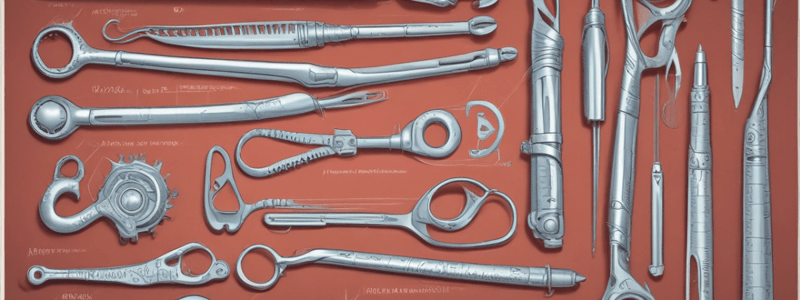Podcast
Questions and Answers
What is the primary focus of the CDC mandate regarding medical device reprocessing?
What is the primary focus of the CDC mandate regarding medical device reprocessing?
- Compliance with FDA regulations
- Disposal of medical waste
- Adherence to manufacturer's instructions (correct)
- Sterilization of medical devices
What does the IAHCSMM recommend involving the 'original equipment manufacturer'?
What does the IAHCSMM recommend involving the 'original equipment manufacturer'?
- Care and cleaning of medical devices (correct)
- Recycling of medical devices
- Purchasing of medical devices
- Quality control of medical devices
What is the primary concern of the U.S. FDA regarding reusable medical devices?
What is the primary concern of the U.S. FDA regarding reusable medical devices?
- Manufacturing quality
- Patient safety (correct)
- Cost-effectiveness
- Environmental impact
Which grade of instrument is made from U.S. and German grade stainless steel?
Which grade of instrument is made from U.S. and German grade stainless steel?
What is the primary characteristic of Sterile disposable Floor Grade instruments?
What is the primary characteristic of Sterile disposable Floor Grade instruments?
When did the FDA issue final guidance on reprocessing RMD?
When did the FDA issue final guidance on reprocessing RMD?
What is the primary focus of the FDA's guidance on reprocessing RMD?
What is the primary focus of the FDA's guidance on reprocessing RMD?
What is the primary characteristic of Physician Grade instruments?
What is the primary characteristic of Physician Grade instruments?
What is the primary concern of the document regarding instrument design?
What is the primary concern of the document regarding instrument design?
What is the advantage of single-use instruments?
What is the advantage of single-use instruments?
What is the characteristic of Austenitic stainless steel?
What is the characteristic of Austenitic stainless steel?
What is the characteristic of 300 Series stainless steel?
What is the characteristic of 300 Series stainless steel?
What is the characteristic of 400 Series stainless steel?
What is the characteristic of 400 Series stainless steel?
What is the use of 12” scissors and forceps?
What is the use of 12” scissors and forceps?
What is the use of 4” delicate scissors and forceps?
What is the use of 4” delicate scissors and forceps?
What is the purpose of a curette?
What is the purpose of a curette?
What is the purpose of a needle holder?
What is the purpose of a needle holder?
What is the purpose of gold plating on an instrument?
What is the purpose of gold plating on an instrument?
Study Notes
Instrument Quality and Classification
- OR Grade: highest quality surgical instruments made from US and German grade stainless steel for surgical settings.
- Mid Grade: high-quality instruments made of Pakistani stainless steel for clinics, physician's offices, and surgical settings.
- Physician Grade: forged from surgical grade Pakistani stainless steel for routine surgical or diagnostic use in office settings.
- Sterile Disposable Floor Grade: ready-to-use, sterile disposables made of Pakistani steel for surgical settings, combining low cost with reliable performance.
- Floor Grade: made of Pakistani steel, combining convenience with reliable function at an affordable cost for non-critical applications.
Regulatory Guidelines
- CDC: instrument end-users must comply with all steps as directed by the device manufacturer.
- IAHCSMM: recommends involving the original equipment manufacturer in processes such as care and cleaning, and instrument asset management.
- US FDA: emphasizes the need for manufacturers to validate instructions for usage, labeling, and reprocessing for device user community, prioritizing patient safety.
Instrument Materials
- Austenitic Stainless Steel: softer, more malleable type within the 300 Series, used for probes, dilators, retractors, and basins.
- Martensitic Stainless Steel: hardened steel within the 400 Series, used for hemostats, needle holders, scissors, clamps, forceps, etc.
- 300 Series Steel: has extreme corrosion resistance, is non-magnetic, contains high chromium content and nickel, and is workable and malleable.
- 400 Series Steel: has good corrosion resistance, can be heat-treated to varying degrees of hardness and sharpness, and has high carbon content.
Instrument Uses and Characteristics
- 410 Series Steel: used for gripping instruments like forceps, tweezers, retractors, and dressing forceps.
- 420 Series Steel: used for cutting instruments such as bone rongeurs, chisels, gouges, and scissors.
- Gold Plating: introduces tungsten carbide, an extremely hard metal that increases and maintains sharpness, strength, and gripping capability.
- 12" Scissors: used for cardio, thoracic, and gynecology.
- 4" Scissors: used for pediatric, ophthalmic, and plastic surgeries.
Instrument Designs and Functions
- Scissors: used to cut tissue or other materials.
- Forceps: have interlocking teeth or serrated jaws used to grasp tissue.
- Sponge and Towel Clamps: hold gauze or wall-off surgical areas.
- Needle Holders: drive suture needles through tissue.
- Retractors: access and expose wounds.
- Hooks: grasp bone, tissue, and suture strands during procedures.
- Curettes: cut or scrape bones or sockets.
- Bone Files and Rasp: smooth bone and cartilage.
- Bone Chisels and Osteotomies: cut or mark a bone.
- Instrument designs include tips, jaws or blades, spring joints, screw joints or box locks, ratchets, shanks, and finger rings.
Studying That Suits You
Use AI to generate personalized quizzes and flashcards to suit your learning preferences.
Description
This quiz covers the different grades of surgical instruments, including OR Grade, Mid Grade, Physician Grade, and Sterile Disposable Floor Grade, and their uses in various medical settings.



